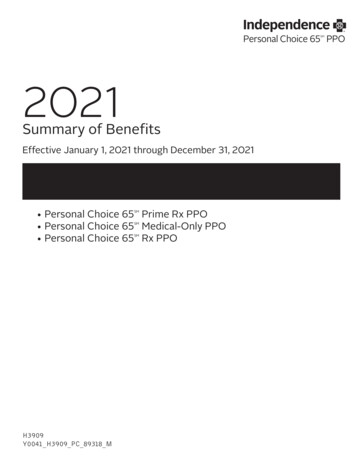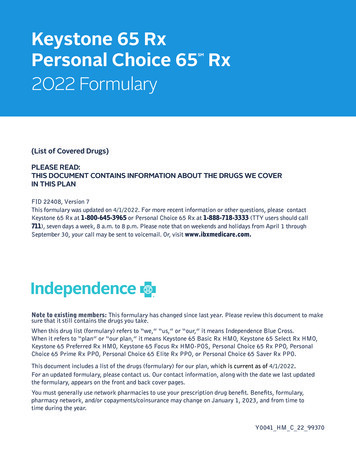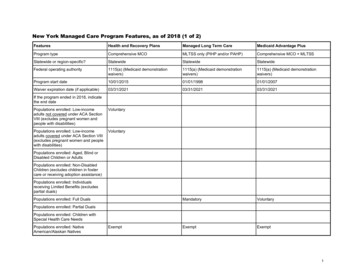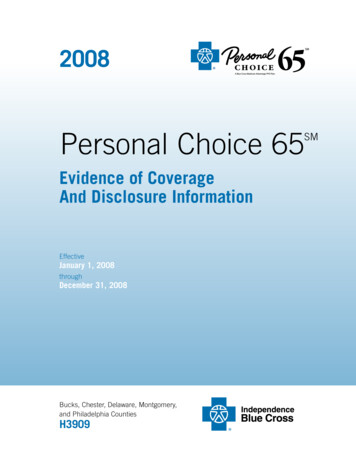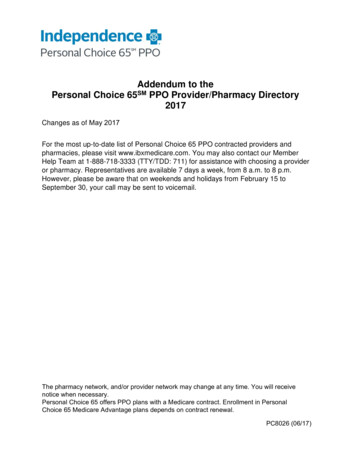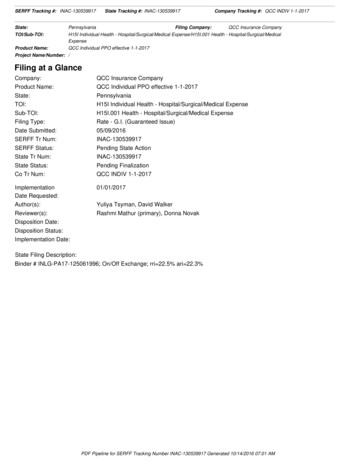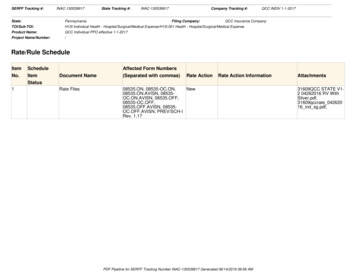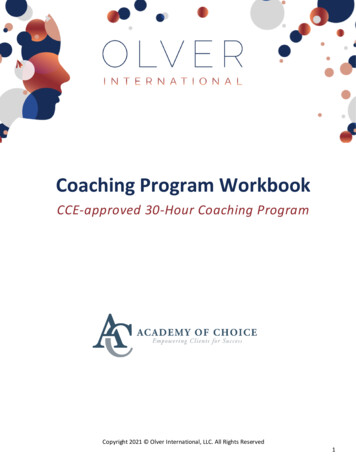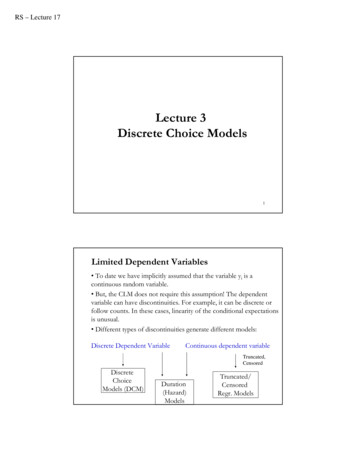
Transcription
Personal Choice ProgramProvider ManualPlease Note:This manual should not be construed to supplant Medicaid PersonalChoice Program Rules and Regulations but rather to supplement those Rules andRegulations. In the event of a conflict between this manual and the Rules and Regulations,the Rules and Regulations shall prevail. Moreover this manual shall not be construed toprovide any exhaustive description, criteria, definition or process and should not beconstrued as providing any type of legal standards whatsoever.December 8, 20151
Table of ContentsChapter 1:IntroductionOverviewDefinitionsRolesParticipant Rights and ResponsibilitiesInvoluntary DisenrollmentDisenrollment Appealpg.pg.pg.pg.pg.pg.pg.Chapter 2:Screening, Acceptance and AdmissionSelf-Direction AssessmentParticipant Management Criteriapg. 10pg. 10pg. 11Chapter 3: Assessment CriteriaAssessmentHow the budget is calculatedProcess used to determine monthly budgetChapter 4: Individual Service and Spending Plan (ISSP)BudgetingBudget Appeals ProcessParticipant Directed Goods and ServicesWriting an ISSPWriting and Submitting the ISSPChapter 5: Advisement pg.171717171920Program Monitoringpg. 24pg. 25Chapter 6:Medicaid FraudPersonal Choice and Medicaid FraudMedicaid Fraud Referral Processpg. 28pg. 28pg. 28Chapter 7:Critical Incidentpg. 30AppendixPersonal Choice PCA & Representative DisqualificationSelf Direction AssessmentPersonal Choice Participant Management Skills AssessmentRequest for Participant-Directed Goods and ServicesDHS-121, Request for HearingDHS-121, InstructionsExcluded from the Duties of a PCASample Personal Choice Quarterly Visit LogSample Personal Choice Monthly Case LogRI Attorney General Medicaid Fraud Referral FormCritical Incident Report 4041424344
Chapter 1IntroductionWelcome to the Personal Choice Program. Personal Choice is designed to give LongTerm Care Medicaid eligible individuals more control over how they receive personalcare services. This manual is designed to give you basic information about the program,assist you in managing your caseload, and help to answer your questions.OverviewPersonal Choice is: A Long Term Care Service for people with disabilities over the age of (18)eighteen or elders aged (65) or older. For individuals who meet either a high or highest level of care. For individuals who want to either return home or remain at home. For individuals who want to purchase their own care and services from abudget based on their individual functional needs. For individuals who have the ability to self-direct care or who have arepresentative who is able to direct care for the participant. Provide assistance to the participant by a Service Advisor and a FiscalIntermediary.The goal of the Personal Choice Program is to provide a home and community-basedprogram where individuals who are eligible for Long Term Care services have theopportunity to exercise choice and control (i.e., hire, fire, supervise, manage)individuals who provide their personal care, and to exercise choice and control over aspecified amount of funds in a participant-directed budget. Participants choose asappropriate or applicable a service advisement agency and a fiscal agent to assist inmaking informed decisions that are consistent with their needs and that reflect theirindividual circumstances.DefinitionsAssessment: A meeting between the participant, and/or representative and theService Advisor. The assessment evaluates Activities of Daily Living (ADLs) andInstrumental Activities of Daily Living (IADLs) to determine participant needs.Assessments also help to identify services, equipment, home modifications and otherservices in the community that may help the participant to increase theirindependence within the community. Assessments occur at the beginning of theprogram and then annually as long as the participant is enrolled in Personal Choice.Either the participant or their representative may request an assessment sooner if theirsituation has changed and there is either an increased or decreased need forassistance.3
Budget Amount: Medicaid funds set aside for the participant’s personal careservices. The budget is based on the amount of assistance the participant requires tomeet his/her personal care needs.Participant (Consumer) Direction: An approach to long-term care whereparticipants manage their own personal care services. Participants assess needs,decide how their needs are to be met, and monitor the quality of the services theyreceive.Fiscal Intermediary Services: Services designed to assist the participant inallocating funds as outlined in the Individual Service and Spending Plan and tofacilitate employment of personal assistance staff by the participant. Personal Choicefinancial matters are maintained by the fiscal agency and a portion of the participant’smonthly budget is set aside to pay the agency for the services it provides.Home Modifications: Equipment and/or adaptations to a participant’s residence toenable the participant to remain in his/her home or place of residence, and ensuresafety, security, and accessibility.Individual Service and Spending Plan (ISSP): A written plan describing theparticipant’s personal care needs and how he/she will meet them by hiring personalcare attendants (PCA). The ISSP also includes a plan for handling emergencies.Allocation for other goods and services and savings are also included in the plan.Participant: A person who is a Medicaid recipient and has chosen to receive his/herpersonal care services through the Personal Choice Program.Participant Directed Goods and Services: Services, equipment, or supplies nototherwise provided through this program or through the Medicaid State Plan thataddress an identified need in the ISSP (including improving and maintaining theindividual’s opportunities for full membership in the community).Personal Care Attendant (PCA): A person who provides personal care services tothe Personal Choice participant. Certain people are not allowed to be the Personalcare attendant including the following; a spouse, legal guardians, financial power ofattorneys, and individuals with certain criminal convictions.Personal Care Services: Services provided in the home or community providingdirect support to individuals in performing tasks that due to their illness and/ordisability they are functionally unable to complete independently.Representative: A person designated by the Personal Choice participant to assisthim/her in managing some or all of the requirements of the program. ARepresentative cannot be paid to provide this assistance. The representative alsocannot be paid to provide direct care or hands on care.Service Advisement Services: An advisement team consisting of the ServiceAdvisor, an RN, and a Mobility Specialist whose focus is on empowering participants4
to define and direct their own personal assistance needs and services. The Service5
Advisor guides and supports, rather than directs and manages the participant throughthe service planning and delivery process. A portion of the participant’s monthlybudget is set aside to pay the agency for the services it provides.Taxes: Fees deducted from the participant’s monthly budget that are required to bepaid on behalf of employees (PCAs): FICA (Federal Insurance Contributions Act): Finances care for the aging,disabled, and survivors. Including funding for Medicare for people whocannot afford medical insurance. FUTA (Federal Unemployment Tax Act): Finances employment programsat the federal level. SUTA (State Unemployment Tax Act): Finances employment programs atthe state level. RITDI (Rhode Island Temporary Disability Insurance): Provides income toemployees who cannot work for a period of time due to illness or injury.Worker’s Compensation Insurance: Funds that provide for monetary awards paid toindividuals who are injured, disabled or killed on the job. Worker’s CompensationInsurance is a cost of employment paid by the participant from his/her monthly budget.RolesThe Personal Choice Program is designed for a participant to have maximum control overthe services received while adhering to the requirements of Medicaid, which fundPersonal Choice services. Two types of agencies provide participant’s with assistance:1) Service Advisement Agency2) Fiscal Advisement AgencyTheir roles in assisting participants are as follows:The Service Advisement Agency: Assesses participant needs. Identifies which services a participant may need. Works with the participant to identify realistic and achievable goals Assist the participant if needed in obtaining an annual physician medical formfor Level of care determination, Assists the participant in completing the initial LTC application and annualLTC recertification , if needed. Works with Fiscal Intermediary and participant in developing an ISSP thatmeets Participants’ goals and needs Assists in determining amount of assistance needed, how much to payPersonal Care Attendants, and how to find and interview Personal CareAttendants. Monitors program by conducting regular home visits and reassessments,including at least one unannounced home visit, per the Personal ChoiceCertification standards6
Provides support and guidance with other social service needsThe Fiscal Advisement Agency: Assists the participant in obtaining Worker’s Compensation Insurance Completes annual criminal background checks on all potential PCAs andRepresentatives. Assists the participant with procedures and forms to use when hiring orchanging PCAs.7
Advises PCAs of their rights as employees.Help the participant to understand the procedures and forms to use forreporting the hours worked by their PCAs (timesheets).Reviews the PCA timesheet to make sure they agree with the approvedISSP.Completes a monthly check of the List of Excluded Individuals and Entities(LEIE) and Federal General Services Agency(GSA) data bases as specifiedin the CMS Federal Code of Regulations.Makes payments to PCAs based on participant instructions and approvedISSP.Will perform all necessary payroll functions.Develops and provides ISSP figures to participant and Service AdvisementAgency for review .Reviews all payments for items and services to make sure they are a part ofthe approved ISSP.Pays for items or services that a participant purchases based on the approvedISSP.Tracks how the participant is spending their budget by providing theparticipant with spending reports every 6 – 8 weeks, and will provide theparticipant with a spending report if requested by the participant or theirrepresentative.Participant Rights and ResponsibilitiesThe following is a brief list of the rights and responsibilities of a Personal Choiceparticipant.A participant has the right to: Be treated as an adult, with dignity and respect at all times. Privacy in all interactions with the agency and freedom from unnecessaryintrusion. Make informed choices based upon appropriate information provided to them,and have those choices respected, while respecting the rights of others todisagree with those choices. Freely choose between approved providers as appropriate or applicable Feel safe and secure in all aspects of life, including health and well- being; befree from exploitation and abuse; and not be overprotected. Realize the full opportunity that life provides by not being limited by others, bymaking full use of the resources the program provides, and by being free fromjudgments and negativity. Live as independently as they choose. Have their individual ethnic background, language, culture and faith valued andrespected. Be treated equally and live in an environment that is free from bullying,harassment and discrimination. Voice grievances about care or treatment without fear of discrimination or8
9reprisal.Voluntarily withdraw from the program at any time.Ask questions until they understand.
Manage PCAs by:o Deciding who to hire to assist you.o Deciding what special knowledge or skills the PCA must possess.o Training each PCA to meet your individual needs.o Replacing PCAs who do not meet your needs. Request a new assessment if their needs change.Create an Individual Service and Spending Plan (ISSP) to meet needs withinthe Personal Choice program guidelines, and to change the plan as needs orgoals change.Know about all service advisement and fiscal advisement agency fees.Receive a report on how they have spent their monthly budget, if requestedby the Participant or their representative.Appeal any decision made by the Service Advisement Agency, FiscalAdvisement Agency, or Medicaid Agency and expect a prompt response.A participant has the responsibility to: Manage and maintain their health and access medical help as needed, orseek assistance in order to do so. Do not make decisions or act in such away that would place their health and safety at risk. Demonstrate the required skills and abilities needed to self-direct PCAswithout jeopardizing health and safety, or designate a representative toassist them. 10Act as a supervising employer by:o All staff and/or representative must submit to a criminal background andabuse registry screening, to be facilitated by the Fiscal Intermediary.Assisting the Fiscal Intermediary in monitoring staff follow through withobtaining yearly criminal background checks.o Deciding wages and schedules for PCAs.o Completing hiring agreements with each PCA.o Following all employment laws and regulations.o Following all requirements of the Fiscal Advisor/IRS for hiring andpaying PCAs including: completing all necessary forms.o Treating all employees with dignity and respect.o Being aware of the Personal Choice rules and regulationso Understand what Medicaid Fraud iso Reviewing timesheets for accuracy and submitting them in a timelymanner, and paying PCAs promptlyManage personal care services by:o Meeting and cooperating with the Service Advisor as required forcompleting all needed assessments and monitoring.o Developing and monitoring an ISSP to address personal care service needswithin the requirements of Personal Choice.o Hiring and supervising PCAs, and ensuring they are performing theirduties as needed.
o Tracking expenses so that the budget is not exceeded.o Notifying Service Advisement agency and Fiscal Intermediary of absencesfrom home that are non-medical( vacations or trips) .o Notifying the Service Advisement Agency of any changes in medicalstatus or admissions to hospitals or other medical facilities. Inaddition notifying your Service Advisor if other services are beingprovided to you. (Visiting Nurses or Hospice for example)o Ensuring a safe working environment for PCAs.o Developing an emergency back-up plan.o Provide orientation and training to PCA staff.11
o Schedule PCA staff and ensure that PCA(s) do not work over 40 hours perweek.o Terminate PCA staff if necessary and notify the fiscal intermediary whentermination occurs.o Contact the fiscal intermediary in the event of a billing or paymentcomplaint.o Only make purchased of items that are included in the Individual Serviceand Spending Plan.Involuntary Disenrollment from Personal Choice ProgramThe service advisement agency can remove a participant from the Personal Choiceprogram if either the participant or representative does not comply with program policy.The service advisement agency must notify the participant/representative in writingstating that they intend to remove them from the Personal Choice Program, the reason fordisenrollment, and inform the participant/representative that services will be providedthrough Medicaid Long Term Care via a home health agency.Involuntary disenrollment may occur when:o The loss of eligibility, either Medicaid financial eligibility, or levelof care eligibility will result in disenrollment.o The participant proves to be unable to self-direct purchase andpayment of long- term care.o A representative proves incapable of acting in the participant’s bestinterest.o The participant/representative fails to comply with legal/financialobligations as an employer of domestic workers and/or is unwillingto participate in advisement training or training to remedy lack ofcompliance.o The participant/representative is unable to manage the monthlyspending as evidenced by repeatedly submitting time sheets forunauthorized budgeted amount of care, underutilization of themonthly budget, which results in going without personal careassistance, and continual attempts to spend budget funds on nonallowable items and services.o Failure of the participant to maintain health and well-being throughthe actions and/or inaction of participant/representative may result indisenrollment.o An inability to maintain a safe working environment for personalcare assistants’ may result in disenrollment.o The receipt of substantiated complaints of self-neglect, neglect orother abuse on either the part of the participant or representative willresult in disenrollment.o A refusal by either the participant or representative to cooperatewith minimum program oversight activities, even when staff hasmade efforts to accommodate the participant/representative willresult in disenrollment.12
oThe representative can no longer assist the participant, and noreplacement representative is available.o The failure by the participant/representative to pay the amountdetermined in the post eligibility treatment of income as describedin section 0392.15.13
commonly referred to as the client share, to the fiscal agency will result indisenrollment.o The Service Advisement agency determines they are unable to provide properservice to the participant. Proper service is defined as the agency not beingable to meet repeated requests for services, being unable to satisfy your needs,and/or provide you with a quality working relationship.o Evidence that Medicaid funds were used improperly/illegally in accordancewith local, state or federal regulations will result in disenrollment.o The participant/representative must notify both the Service Advisementagency and the Fiscal Intermediary of any change of address and/or telephonenumber within 10 days of change occurring, failure to do so will result indisenrollment.Disenrollment AppealThe Service Advisement Agency and the Fiscal Intermediary Agency will inform theparticipant/representative in writing of an involuntary disenrollment with the reason andwill provide you with a Medicaid appeal procedure and request forms. You have the rightto appeal utilizing the Medicaid standard appeal process.14
Chapter 2Screening, Acceptance and AdmissionEach advisement agency shall define the population it intends to service under PersonalChoice as follows: A long term care service for people with disabilities over the age of(18) eighteen or elders aged (65) or older who do receive services from BHDDH andmeet either a high or highest level of care, want to remain or return home, and have theability to purchase and direct own care and services from a budget based on individualfunctional needs.The Service Advisement agency will have a mission and philosophy statement thatreflects the needs of the participant, the services, and supports it is committed to provide,and a commitment to the philosophy of Consumer Direction and personal choice.Keeping this philosophy in mind, the Service Advisement agency will provide theapplicant with information about not only Personal Choice, but also other available Homeand Community based care in order to assist the applicant in making an informed choice.Basic eligibility criteria for the Personal Choice program include, but are not limited to:o A disability affecting either cognitive or physical capacity to complete ADL’s/IADL’s in a safe or timely manner.o Eligible for Medical Assistance through the Medicaid Long Term Careeligibility rules.o Meet either a high or highest level of care as determined by the MedicaidOffice of Medical Review.o Possesses the ability to self-direct and manage all aspects of their personalcare and community living needs.Self- Direction AssessmentThe participant self-assessment is designed to assist the Service Advisor in determining ifthe applicant possesses the ability to self-direct and manage his/her own care. Thequestions are intended to elicit information needed for the Service Advisor to determineeligibility for the program and/or the need for a representative to assist the participant.Since Personal Choice participants will be responsible for overseeing the day-to-dayprovisions of services it is important that they possess the ability and the desire to beinvolved in this process. The participant must have the ability to make choices, set goals,be aware of what is adequate or inadequate care, and make changes as to how their care isprovided if necessary. A key component in ensuring that each individual Personal Choiceparticipant is receiving high quality care in this type of consumer directed programis to assure that he/she has the ability to recognize and monitor his/her programindependently.15
The applicant should be asked all of the questions. The inability to answer one or twoquestions may not necessarily indicate the inability to self-direct their own care, but mayindicate the need for more guidance, education, and training in those areas in question.The Service Advisor should also rely on observation of the applicant, and how theyrespond and answer each question.The purpose of this tool is to determine if the applicant is capable of managing thePersonal Choice program after they receive information and training. This tool is alsointended to show the applicant areas of deficit and issues of concern that may preventthem from operating the program safely and efficiently. Finally, it is designed to assistthe applicant in deciding whether or not a representative may be needed to assist them inmanaging some or all aspects of the program that they may have difficulty in doingindependently.The questions can be found in the appendix section of this manual. This assessment willbe filed in the participant case record.Participant Management CriteriaA Service Advisor prior to the start of a self-directed program should determine if theapplicant possesses the requisite skills to manage a self-directed Home and CommunityBased assistance program. This tool is different from the Self-Direction Assessment inthat this is more of a hands-on program assessment, giving the Service Advisorinformation as to whether the participant/representative understands how the programworks.The questions will be asked of all prospective participants/representatives, and theService Advisor will record the answers to the questions which will be filed in theparticipant case record. All of the questions are designed to elicit answers that shouldindicate the participant’s/representative’s ability and/or readiness to take part in theprogram. Some of the questions (#’s 2, 12, 13 and 14 specifically) do not necessarilyhave a right or wrong answer, but rather are meant to determine if theparticipant/representative understands the concepts and philosophy of the program aswell as their ability to recognize their responsibilities in the area of quality management.It is up to the Service Advisor to determine if the participant/representative possesses theskills required to manage a self-directed program, and to provide guidance, support andtraining in areas where assistance is indicated. The questions can be found in theappendix section of this manual.16
Chapter 3Assessment CriteriaAssessment criteria will include, but not necessarily be limited to the following:o A Case Manager from the Service Advisement agency will conduct an initialassessment as detailed below.o An environmental accessibility and health/medical assessment are to beconducted as part of the intake process once the initial assessment has beencompleted.AssessmentsAn assessment measuring Activities of Daily Living (ADLS) and Instrumental Activitiesof Daily Living (IADLS) is conducted to determine participant needs. A budget isdeveloped based on the amount and level of assistance required, frequency of the task,and presence of any secondary conditions that would require a need for more time tocomplete the task. There are six (6) levels of assistance for each activity (refer to chartbelow). In addition to medical information and self-reporting, the assessor may observeor request the participant to demonstrate their ability to complete a task. The participantmay direct the assessor to obtain information from friends/family who are aware of theparticipant’s abilities. Information for the assessment should not be obtained from thePersonal Care eTotal AssistanceNot ApplicableParticipant is independent in completing the task safely.Participant requires brief supervision, cueing, reminderand/or set-up assistance to perform the task.Participant is actively involved in the activity, requiressome hands-on assistance for completion, thoroughnessor safety. Needs verbal or physical assistance with 25%of the task.Participant requires extensive hands-on assistance, but isable to assist in the process. Needs verbal or physicalassistance with 50% of the task.Participant requires verbal or physical assistance with75% of the task.Participant cannot participate or assist in the activity, andrequires 100% assistance with the task.This task does not apply to this participant.During the assessment the Medicaid Agency or its contracted agency will assess theassistance a participant requires to complete tasks. These tasks can be broken down intotwo areas: Personal Care tasks such as bathing, toileting, dressing, etc., and NonPersonal Care tasks such as housekeeping and meal preparation. Participants are notassessed for general supervision, watching, or companionship as these services are17
not covered under the Personal Choice Program. Deciding how to meet these needs18
involves coming up with a plan of hiring people to do the tasks, or purchasing goods orservices that will allow the participant to complete the task themselves.How the Personal Choice Budget is CalculatedOverviewPersonal Choice monthly budgets are based upon an assessment of participant need forhands on assistance or supervision in the following Activities of Daily Living (ADL’s)which include: bathing, toileting, dressing, grooming, transfers, mobility, skin care, andeating; and Instrumental Activities of Daily Living (IADL’s) which include:communication, shopping, housework, and meal preparation.The assessment of need rates the level of assistance required to complete each task, andthe number of times the task is performed. If a participant has a particular condition orcharacteristic in addition to their disability, it may require the need for more time tocomplete a particular task. These conditions/characteristics do not apply to allADL/IADL tasks listed above; they only apply if the condition would have a directimpact on the performance of the task. Those conditions may include: balance problems,behavioral issues, cognitive deficits, decreased endurance, fine motor deficits, hearingloss, limited range of motion, open wound, pain, seizures, shortness of breath,spasticity/muscle tone, use of oxygen, limited vision, and living alone.The Service Advisor will take into consideration care being provided by a non-paidformal or informal caregiver. For example, if a spouse is cooking dinner for herself, andher spouse is a diabetic, the expectation would be the spouse would provide that meal forthe participant. Personal care provided multiple times per day must show documentationof need. For example, if a participant is incontinent they may require bathing orshowering more than once a day, but if there is no medical need, a single shower/bathshould suffice.Process Used to Determine Monthly BudgetEach Activity of Daily Living (ADL) and Instrumental Activity of Daily Living (IADL)has an amount of time allowed to complete the task.The unit time is the amount of time allowed to complete the task if the participant isunable to participate and require total assistance with the task.The functional time is the amount of time allowed to complete the task if the participantis unable to participate and require total assistance with the task and certain conditions orcharacteristics are present. Those characteristics are listed in functional characteristictable below.19
The times, in minutes, are as follows:ActivityUnit TimeSponge Bath20Shower20Tub ransfers5Grooming5Skin Care5Bowel20Meal Preparation20House Work12.5Communications10Shopping45Functional Time35304520401015108104020251045The functional characteristics for each ADL/IADL are as follows:ADL/IADLFunctional CharacteristicsBowelBehavioral Issues, Limited ROM,Spasticity/Muscle ToneDressingBehavioral Issues, Limited ROM,Spasticity/Muscle ToneEatingBehavioral Issues, Fine Motor Deficit,Spasticity/Muscle ToneGroomingCognitive, Limited ROM,Spasticity/Muscle ToneMobilityBalance Problems, Decreased Endurance,Pain, Spasticity/Muscle ToneShowerBalance Problems, Behavioral Issues,Limited ROM, Spasticity/Muscle ToneSkin CareOpen WoundSponge BathBehavioral Issues, Limited ROM,Spasticity/Muscle ToneTransfersBalance Problem, Limited ROM,Spasticity/Muscle ToneTub BathBalance Problem, Behavioral Issues,Limited ROM, Spasticity/Muscle ToneUrinary/MensesBehavioral Issues, Limited ROM,Spasticity/Muscle ToneCommunicationsNo Functional CharacteristicsHouseworkParticipant Lives AloneMeal PreparationNo Functional CharacteristicsShoppingNo Functional Characteristics20
A participant’s Level of Assistance need determines the amount of time allowed forhands on assistance or supervision for each task. Times allotted for each task aredetermined by multiplying
Welcome to the Personal Choice Program. Personal Choice is designed to give Long Term Care Medicaid eligible individuals more control over how they receive personal care services. This manual is designed to give you basic information about the program, assist you in managing y
